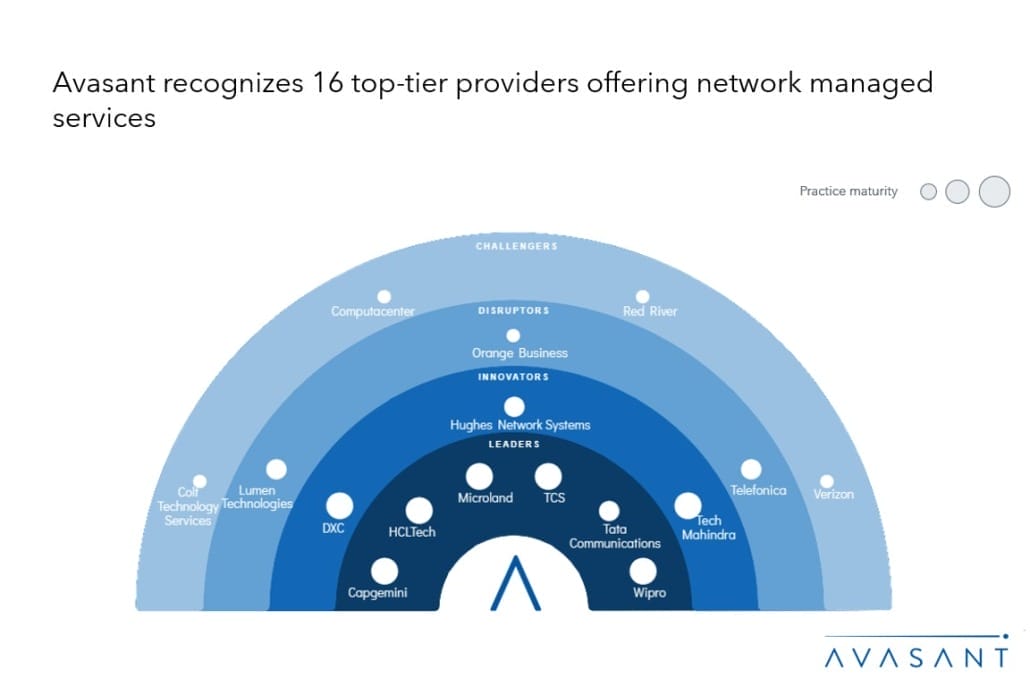Enterprises encounter several challenges in managing their network infrastructure, such as scalability issues, security vulnerabilities, and resource limitations. In today’s dynamic digital environment, it is crucial for businesses to overcome these challenges to adapt to evolving demands and remain competitive and resilient. This requires comprehensive assessments, strategic planning, and tailored technology implementation. Furthermore, effective network monitoring, maintenance, and troubleshooting are vital to ensuring seamless operations and minimizing downtime. Additionally, service providers are helping enterprises with proactive security measures, compliance adherence, and efficient resource utilization, empowering enterprises to focus on core objectives while effectively managing network complexities.
Both demand-side and supply-side trends are covered in Avasant’s Network Managed Services 2023–2024 Market Insights™ and Network Managed Services 2023–2024 RadarView™, respectively. These reports present a comprehensive study of network managed service providers and closely examine the market leaders, innovators, disruptors, and challengers.
We evaluated 46 service providers across three dimensions: practice maturity, partner ecosystem, and investments and innovation. Of the 46 providers, we recognized 16 that brought the most value to the market during the past 12 months.
The report recognizes service providers in four categories:
-
- Leaders: Capgemini, HCLTech, Microland, TCS, Tata Communications, and Wipro
- Innovators: DXC, Hughes Network Systems, and Tech Mahindra
- Disruptors: Lumen Technologies, Orange Business, and Telefonica
- Challengers: Colt Technology Services, Computacenter, Red River, and Verizon
Figure 1 below from the full report illustrates these categories:

“In today’s rapidly evolving digital landscape, enterprise success relies on the seamless operation of networks,” said Avasant Senior Director Mark Gaffney. “Enterprises using next-generation big data and AI tools to optimize network traffic, improve security, and automate troubleshooting processes can enhance network services performance.”
The reports provide several findings, including the following:
-
- Around 20% of the traction for network managed services comes from the manufacturing industry because of its reliance on high-performance networks to support critical operations such as supply chain management, inventory tracking, and automated production.
- Enterprises leverage generative AI to create network designs, configure network devices and firewall rules, automate observability processes, and manage incidents.
- Service providers are adopting a platform-led approach to deliver network managed services, integrating advanced AIOps capabilities. These capabilities enable enterprises to monitor network performance and optimize network operations.
- Within network modernization projects, nearly 75% of network service provider investments are dedicated to asset and talent development.
“Network monitoring safeguards businesses from disruptions and enables proactive decision-making,” said A. Tarun, lead analyst with Avasant. “By providing real-time insights and data, network monitoring empowers businesses to anticipate challenges such as bandwidth bottlenecks, security breaches, and infrastructure failures.”
The Network Managed Services 2023–2024 RadarView™ also features detailed RadarView profiles of 16 service providers, along with their solutions, offerings, and experience in assisting enterprises in their network modernization journeys.
This Research Byte is a brief overview of the Network Managed Services 2023–2024 Market Insights™ and Network Managed Services 2023–2024 RadarView™ (click for pricing).


